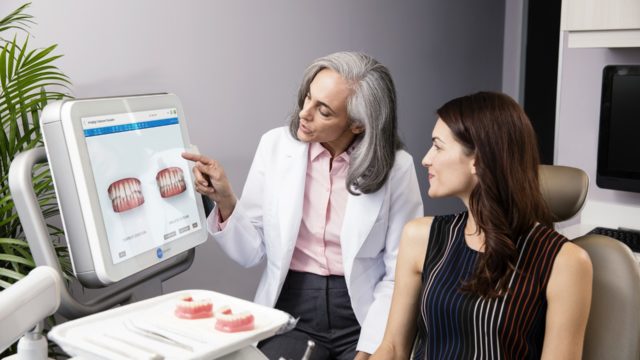Article at a Glance

- Three-dimensional or 3D scanning involves converting images of a physical model into digital 3D images.
- 3D scanning allows for more accurate digital models of the teeth and mouth with less mess and discomfort.
- 3D scanners allow dentists to help more patients in less time and lower overall medical costs.
Technological advancements have improved service and quality in every industry, but especially areas of medicine. We’ve come a long way from the early days of dentistry, some 14,000 years ago. New and improved tools enter the market every year to make dental work easier, cleaner, and more efficient than ever. One of the newest advancements is three-dimensional (3D) scanning and it has revolutionized dentistry.
How Do 3D Scanners Work?
3D scanning is a method of using a physical model to create 3D computer-aided design (CAD) files. In simpler terms, it’s the process of taking multiple pictures of something from all angles and blending them to create a three-dimensional image on a computer. The applications are almost endless for creating custom attachments or parts for repairs or enhancements of the original model.
Why Use 3D Scanning in Dentistry?
As noted, there are several applications for 3D scanning for creation of parts and attachments, especially in medicine. In dentistry, this could be dentures, orthodontics, like Invisalign, or even 3D printed teeth. Oral surgeons can even utilize 3D scanning technology for more efficient procedures and educators can better prepare dental students for real-life applications.
Also known as intraoral scanners, 3D scanners are easy and efficient for dental offices to use. Only one person is needed to operate the equipment because the scanner only requires use of a small “wand.” The dental professional moves this wand around your mouth to capture images of your teeth. Thousands of frames per second are captured and spliced together to create a model of your mouth on a monitor. The images can be reviewed immediately to ensure they are sufficient. This allows your dentist to capture any additional images needed instead of asking you to return for follow-up visits. The former method of using molds and impressions may have required multiple follow-ups which meant a lot of ill-tasting, goopy gunk in your mouth.
3D scanners are more efficient and more accurate than traditional molds. Several studies have been done to assess the advantages and disadvantages of using 3D scanners.
- 3D scanners are noted to be more comfortable for patients because they use a small wand that can capture images of the hardest to reach parts of the mouth without triggering your gag reflex.
- Intraoral scanners use small wands to capture images which makes the experience far less messy than the goop used to create molds. It’s cleaner and easier for everybody involved!
- 3D scanning can be completed in a matter of minutes by one person instead of using multiple supplies and a team.
- Results can be instantly reviewed and transmitted to technicians whereas the mold/impression method may take weeks to arrive.
- The process of taking 3D scans is simpler, even in the most complex cases.
- Communication is easier with technicians and patients and fewer appointments are necessary to complete the process.
- Images from 3D scanners tend to be more detailed and accurate because they can detect even the slightest crevices.
- Dental 3D scanners are more cost effective for dental offices which can lower medical costs for you.
How Dental 3D Scans Can Help You
Jefferson Dental Care is proud to use iTero Element Scanners in our clinics. iTero scanners are easy to use and efficient for orthodontic treatments and restorative treatments like crowns, bridges, and implants. These portable scanners make the process more comfortable for you and allow us to show you a simulation of your post-treatment smile so we’re on the same page. The process is quick and accurate. You’ll even be able to breathe and swallow normally the entire time.
If you’re interested in Invisalign clear aligners, dentures, or dental implants, or other ways to improve your smile, make an appointment at the Jefferson Dental Care clinic nearest you.




